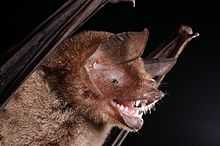Parnell's mustached bat
| Parnell's mustached bat | |
|---|---|
 | |
| Conservation status | |
| Scientific classification | |
| Kingdom: | Animalia |
| Phylum: | Chordata |
| Class: | Mammalia |
| Order: | Chiroptera |
| Family: | Mormoopidae |
| Genus: | Pteronotus |
| Species: | P. parnellii |
| Binomial name | |
| Pteronotus parnellii Gray, 1843 | |
| Subspecies[2] | |
|
P. p. parnellii | |
Parnell's mustached bat (Pteronotus parnellii) is an insectivorous bat native to North, Central and South America. This bat species ranges from southern Sonora, Mexico south to Brazil. Historically, it had a wider range as fossil specimens have been collected on the island of New Providence, Bahamas. It's a large bat with a forearm length of about 60 millimeters. The ears are short and pointed, and they have no noseleafs, but the lips are wrinkled up and modified into a funnel shape.

These bats live mainly in moist areas, although they can also be found in dry deciduous forests. They roost in caves and tunnels, and sometimes live together with other bat species. The females breed once a year. It was previously thought to be the only bat in the New World to perform Doppler-shift compensation behavior.[3]
References
- ↑ "Pteronotus parnellii". IUCN Red List of Threatened Species. Version 2007. International Union for Conservation of Nature. 1996. Retrieved 9 June 2008.
- ↑ Pteronotus (Phyllodia) parnellii. Mammal Species of the World. Bucknell.edu. Retrieved on 2012-12-29.
- ↑ Smotherman, M. & Guillén-Servent, A., Michael; Guillén-Servent, Antonio (2008). "Doppler-shift compensation behavior by Wagner's mustached bat, Pteronotus personatus". J. Acoust. Soc. Am. 123 (6): 4331–4339. doi:10.1121/1.2912436. More than one of
|number=and|issue=specified (help)
- John F. Eisemberg and Kent H. Redford, 2000. Mammals of the Neotropics: Ecuador, Bolivia and Brazil.
- Don E. Wilson, 2003. The Smithsonian book of North American mammals.
- Buden, Donald W. (1986). "Distribution of Mammals of the Bahamas". Florida Field Naturalist 14 (3): 53–84.
